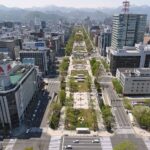In Buenos Aires, using the public transportation system is a cheap and practical way to move around. Buses, commuter trains, underground Metro trains, and trams are all part of the system. There is a robust and effective public transportation system in the city, and services are available all day long. The most popular and least expensive kind of public transportation is the bus. The subterranean Metro is the quickest and most contemporary choice for getting around the city. Suburban commuters choose commuter trains because they provide a more laid-back method of getting about the metropolis. The trams, which are Buenos Aires’s oldest mode of public transportation, are a terrific way to tour the city’s historic landmarks.
Basic information about the Metro system in Buenos aires
Buenos Aires’ metro system makes getting about the city simple and effective. Six lines and more than 80 stations make up the metro system, which provides access to many different parts of the city. On weekdays, the metro runs from 5 am to 11 pm; on weekends and holidays, it runs from 6 am to 10 pm. With tickets as low as 2.75 Argentine pesos, it is the most cost-effective way to travel around the city. With its different routes and convenient stops, the Metrobus line is also a more flexible way to get around the city. Buenos Aires’ Metro system is a fantastic tool for getting to know the city and its people.
The lines of the Buenos Aires subway system
One of the most significant public transportation networks in the nation is the Metro in Buenos Aires. It is the second largest metro system in South America, with six lines and more than 100 stations. The city and its suburbs can be traversed effectively and dependably using this method.
One of the world’s oldest metro systems, the Buenos Aires Metro opened its first line in 1913. It was constructed to ease city traffic congestion and enhance access to various locations.
Color and numbers are used to distinguish the metro lines. Line A is red, Line B is blue, Line C is green, Line D is yellow, Line E is purple, and Line H is the sixth line (orange). Each line travels along its own path and makes stops at various stations.
From Plaza de Mayo to Los Incas, Line A travels. Leandro Alem to Juan Manuel de Rosas are both served by Line B. Retiro and Congreso de Tucumán are connected by Line C. Congreso de Tucumán to Congreso de la Nación is connected by Line D. From Plaza de Mayo to José Hernández, Line E travels. Finally, Line H connects Plaza de Mayo to the Congreso de Tucumán.
An excellent method of transportation in Buenos Aires is the metro. It is inexpensive, dependable, and effective. It is also a terrific method to discover the city’s various neighbourhoods and suburbs. Therefore, the Buenos Aires Metro is the best choice if you’re searching for a quick and affordable means to go around the city.
Map of Buenos Aires Metro 2023 – Free Download in PDF

Finding your way around the city has never been simpler thanks to the development of the Metro of Buenos Aires, which will take place in 2023. The Map of Buenos Aires Metro 2023, which you can get for free in PDF format, makes it easy to find the fastest and most convenient way to get where you want to go. You can organise your trip and determine the best path to get you where you need to go using this detailed map. The Metro Map 2023 will make getting around Buenos Aires faster and simpler, no matter where you’re going.
Public transport tickets in Buenos Aires – Best types for travelers & actual prices
Buenos Aires’ public transportation system makes getting about the city simple and inexpensive. Because there are many different kinds of tickets, it’s important to know how much each one costs and what it includes. Here is a full breakdown of the various ticket categories, their costs, and what they cover.
The “SUBE” card is the most popular type of ticket. This reloadable card works with all forms of public transportation in Buenos Aires. It can be purchased at any kiosk in the city and is a quick and simple way to pay for your rides. The $25 ARS SUBE card is good for up to 10 travels. Each trip costs $2.50 ARS and is valid on trains, buses, and subways.
The “Tarjeta Citybus” is a wonderful option for people seeking a more economical option. This is a prepaid card that works on all of the city’s buses. Each ride is $1 ARS and the card is $5 ARS. It’s ideal for frequent bus users because it’s the least expensive choice offered.
The “Pase libre” card is an excellent option for individuals seeking a more adaptable solution. This card costs $50 ARS and is valid for 30 days. It is compatible with all forms of public transportation, including buses, trains, and subways. Given that it is valid for an entire month, the card is ideal for individuals who must travel regularly.
And finally, the most complete choice is the “Pase anual” card. This card has a yearlong validity and costs $450 ARS. It is compatible with all forms of public transportation, including buses, trains, and subways. For individuals who must travel regularly all year long, this is the ideal choice.
Public transportation in Buenos Aires is generally accessible for a range of fees and tickets. Depending on your needs, the SUBE card, Tarjeta Citybus, Pase libre, and Pase anual are all excellent choices. Making the best choice for your travels will be aided by your knowledge of the various costs and what each ticket includes.
Summary of fares for public transport in Buenos Aires
- SUBE card, which costs $25 ARS and provides 10 trips at a cost of $2.50 ARS each
- Tarjeta Citybus: Prepaid card, $5 ARS, $1 ARS each ride
- Pase libre: $50 ARS, good for 30 days, and applicable to all types of public transit
- Annual Pass: $450 ARS, good for a full year, and accepted on all types of public transit.
Timetables & Schedules of Buenos Aires Metro system
The Buenos Aires Metro system is open from 5 am to 11 pm, with some lines staying open until 12 am on weekends, holidays, and other special occasions. There are often 4-6 trains each hour on average, though the frequency varies from line to line. The frequency rises and the trains are more crowded during peak hours. There are also designated lines for night services that are open until five in the morning. The Buenos Aires Metro system is a fantastic way to navigate the city, providing a comfortable and reasonably priced mode of transportation.
What Are Other Options For Public Transportation In Buenos Aires?
People who live in or visit Buenos Aires need public transportation to get around every day. There are a number of additional ways to move around the city besides the metro, which is the primary mode of public transit.
The bus is the most often used mode of transportation for local travel. The city is completely covered by a substantial network of bus routes. Buses are dependable, reasonably priced, and they run frequently. Bus stations are simple to locate, and the driver will sell you tickets while you’re on the bus.
The colectivo is another another means of transportation in Buenos Aires. Shared vans called colectivos travel along predetermined routes and are typically quicker than buses. They provide fewer stops than buses, but are typically less expensive. On board, tickets can be purchased.
There are also taxi and ride-hailing services for individuals looking for a more practical solution. Taxis are simple to locate and can be called in advance or flagged down on the street. In Buenos Aires, ride-hailing services like Uber and Cabify are also accessible.
Finally, Buenos Aires has a bike-sharing programme for those who want to tour the city on two wheels. Ecobici and Mobike are the two bike-sharing firms in the city. At specific points around the city, cyclists can pick up and drop off the bikes.
In general, Buenos Aires has a wide range of public transportation choices, including taxis, colectivos, buses, and bike-sharing. There is a mode of transportation to meet your demands, no matter what they are or what your budget is.
How To Get From Ministro Pistarini International Airport (eze) To The City Center With Public Transport?
The primary international airport serving Buenos Aires, Argentina, is Ministro Pistarini International Airport, also known as Ezeiza. Travelers looking for the easiest method to get from the airport to the city’s centre may be interested in knowing that it is about 30 kilometres away. Fortunately, travelling from the airport to the city centre via public transportation is an inexpensive and practical choice.
Taking the Airport Bus Express is one of the most well-liked ways to travel from the airport to the city centre. From the airport, a fast bus service travels to the Retiro Bus Station in the heart of Buenos Aires. Tickets must be booked in advance and the trip takes about 45 minutes. Tickets can be ordered online or at the airport’s ticket counter for the fee of AR$180.
Taking a taxi to the city’s centre is an additional choice. Taxis are accessible outside the airport, and depending on traffic, the trip to the city centre takes about 40 minutes. Depending on the time of day, this option might range in price from AR$600 to AR$800. It’s vital to remember that cabs must be reserved in advance, and cash payments are only accepted for fares.
The third choice is to ride a public bus to the city centre from the airport. The fare for this option is the lowest of the three at only AR$30. The trip, however, takes about 90 minutes, and traffic can be heavy. Every hour, public buses leave the airport; tickets are available at the shop outside the arrivals area.
Using public transit to go from the airport to the city centre is simple and reasonably priced, regardless of the mode of transportation you use. Travelers can reach their destination swiftly and safely with a little forward preparation and investigation.
What kind of sightseeing DO you have to see if you visit the Buenos Aires for THE first time?
One of South America’s liveliest and most entertaining cities is Buenos Aires. It is renowned for its vibrant culture, delectable cuisine, and fervent people. There are several great sites to visit for tourists who want to discover the city. Here are some of the top places to go in Buenos Aires, from taking in the breathtaking vistas to examining the city’s rich history and culture.
The Recoleta Cemetery is one of Buenos Aires’ most well-liked sights. Due to the graves of famous Argentinians like Eva Peron and the cemetery’s beautiful architecture, it has become a popular tourist site. Visitors can learn about the history of the city and its residents while touring the cemetery.
Some of the city’s top attractions, like as the zoo, botanical park, and Japanese garden, are located in the Palermo district. The zoo is a terrific site to see animals from all over the world, while the gardens are home to a variety of plants and species.
The Plaza de Mayo is the beating heart of Buenos Aires. Numerous significant landmarks, including the Metropolitan Cathedral and the Casa Rosada, the presidential residence, are located on this area. It is an important part of the culture of the city because it has been the site of many important protests and demonstrations.
One of South America’s most stunning theatres is the Teatro Colon. This neoclassical building, which has been in use since 1908, has been the site of many musical and theater performances. A show or a tour of the theatre are also options for guests.
The San Telmo area should not be missed by tourists who want to learn about the local culture. Numerous museums, cafes, and antique stores are located here. Visitors can also take advantage of the San Telmo Market on Sundays, where vendors offer anything from jewellery to vintage apparel.
Last but not least, visitors ought to wander along the city’s waterfront. The Puerto Madero neighborhood has a lot of restaurants and pubs, as well as beautiful views of the river. It’s the ideal location for a romantic evening or for just taking in the city’s sights and noises.
The city of Buenos Aires is rich in culture, history, and natural beauty. It is simple to understand why it is one of the most well-liked travel locations in South America with so many attractions to discover. Buenos Aires offers something for everyone, whether you want to learn more about the city’s history or just enjoy the breathtaking scenery.
Summary of our tour guide for Buenos Aires
AI (PARAGRAPH): Short summary about Buenos Aires as a city and public transport.
Buenos Aires is a vibrant and bustling city with lots to explore. It is the capital of Argentina and is a popular tourist destination due to its culture, architecture, and attractions. The city has a good public transportation system that includes buses, trains, and the metro. This makes getting around the city easy and cheap. The buses are frequent and the metro lines run across the entire city. In addition, there are plenty of taxis and cycling is becoming increasingly popular. With its efficient public transport and many sights to explore, Buenos Aires is a great city to visit.
Top 5 FAQs and answers about Buenos Aires public transport?
- Does Buenos Aires have good public transport?
- We are not exaggerating when we say that you can get everywhere with public transport. Buenos Aires has a very extensive bus network supported by the metro. Also, it’s a cheap way to get around in Buenos Aires and you will come into more contact with local life.
- What transportation is used in Buenos Aires?
- Buenos Aires has a large, efficient public transport network, almost 40,000 licensed taxis, a hop-on, hop-off sightseeing bus, and a vast network of cycle lanes.
- How much is public transport in Buenos Aires?
- If you want to travel by Subte or use the colectivos in Buenos Aires, you’ll need to get a SUBE travel card. You can fill it up with credit—each trip costs $16.50 ARS ($. 28 USD).
- What are the three most important rules to have on public transportation?
- Public Transportation Etiquette
- Offer your seat to elderly or disabled passengers. If the train or bus is crowded, make sure you leave room for people to move around you. Avoid using the phone as much as possible.
- How much is the metro in Buenos Aires?
- A single ticket for the Subte (Subtepass) costs 16.50 ARS ( US$ 0.10). You can buy tickets for 1 or 10 trips, although the fare is not reduced when buying several at a time. To use public transport you must have a SUBE card.
Useful links







